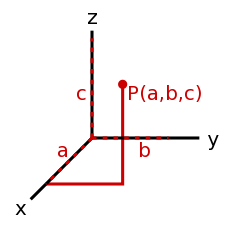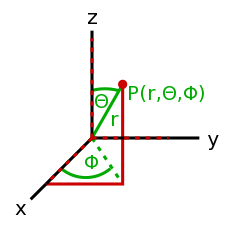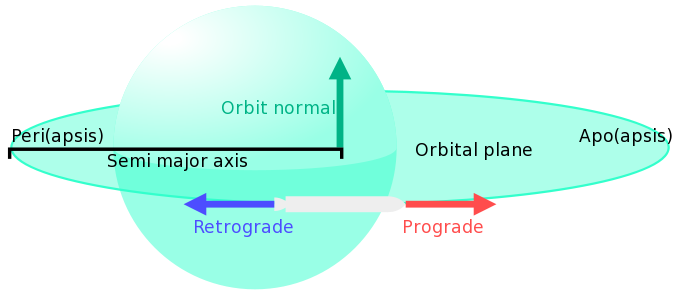Difference between revisions of "Terminology/th"
| Line 128: | Line 128: | ||
;รีโทรเบิร์น(Retroburn) | ;รีโทรเบิร์น(Retroburn) | ||
:การเบิร์นที่ทำให้เกิดการ "ถอยหลัง", เช่น การทำให้เครื่องยนหันไปทางด้านหน้า(Prograde) และด้านหน้าหักไปทางด้านหลัง(Retrograde) โดยปกติจะใช้ท่าการบินนี้สำหรับการลดระดับจุดต่ำสุด([[#periapsis|periapsis]]) และจุดสูงสุด([[#apoapsis|apoapsis]]) | :การเบิร์นที่ทำให้เกิดการ "ถอยหลัง", เช่น การทำให้เครื่องยนหันไปทางด้านหน้า(Prograde) และด้านหน้าหักไปทางด้านหลัง(Retrograde) โดยปกติจะใช้ท่าการบินนี้สำหรับการลดระดับจุดต่ำสุด([[#periapsis|periapsis]]) และจุดสูงสุด([[#apoapsis|apoapsis]]) | ||
| − | == Physics == | + | == ฟิสิกค์(Physics) == |
| − | ;Acceleration | + | ;ความเร่ง(Acceleration) |
| − | : | + | :อัตราการเปลี่ยนแปลงของความเร็ว(Velocity), ความเร่งเป็นเว็คเตอร์ และมีหนวยเป็น "m/s<sup>2</sup>" |
| − | ;Ballistic trajectory | + | ;วิถีกระสุน(Ballistic trajectory) |
| − | : | + | :การร่วงหล่นของวัตถุจะมีวิธีที่เป็นวิถีแบบกระสุน ในเรื่องที่เกี่ยวกับจรวดจะแสดงถึงวัตถุที่มีปฏิสัมพันธ์กับแรงดึงดูดเท่านั้นและไม่มีแรงอื่นมากระทำไม่เว้นแม้แต่แรงขับจรวด |
| − | ;Delta-v (Δv) | + | ;เดลต้าวี(Delta-v (Δv)) |
| − | : | + | :การเปลี่ยนของความเร็วที่กำเนิดมาจากยานอวกาศ และมีหน่วยในการวัดเป็นเมตรต่อวินาที(m/s) มวลที่มากขี้นจะลดเดลต้าวีให้ลดลง แต่หากมีแรงขับมากขึ้นจะสามารถเพิ่มเดลต้าวีได้ ค่านี้เป็นค่าที่สำคัญในการคำนวนความคุ้มค้าและประสิทธิภาพของจรวด ตัวอย่างเช่น การยิงยานต้องการเดลต้าวีประมาณ 4500 m/s ในการออกจากชั้นบรรยากาศและการทำวงโคจรที่มีเสถียรภาพ |
| − | : | + | :จากนิยาม: <math>\Delta{v} = \int_{t_0}^{t_1} {\frac {|T|} {m}}\, dt</math> |
| − | : | + | :เมื่อ''T'' คือแรงขับ, ''m'' คือมวลที่แท้จริง |
| − | : | + | :ถ้าไม่มีแรงภายนอกมากระทำ และทิศทางที่เปลี่ยนไป ผลของการเปลี่ยนแปลงความเร็ว: |
: <math>\Delta{v} = \int_{t_0}^{t_1} {\frac {|T|} {m}}\ dt = \int_{t_0}^{t_1} {|a|}\ dt = | {v}_1 - {v}_0 |\,</math> | : <math>\Delta{v} = \int_{t_0}^{t_1} {\frac {|T|} {m}}\ dt = \int_{t_0}^{t_1} {|a|}\ dt = | {v}_1 - {v}_0 |\,</math> | ||
| − | : | + | :ในกรณีที่มีการคิดถึงแรงพลักจำเพาะ(Specific Impulse): |
: <math>\Delta{v} = | {v}_1 - {v}_0 |_{max}\ = -\int_{t_0}^{t_1} {I_{sp} \cdot g\ \cdot \frac{\dot{m}} {m}}\ dt = {I_{sp} \cdot g \cdot ln( \frac {m_0} {m_1})}\,</math> | : <math>\Delta{v} = | {v}_1 - {v}_0 |_{max}\ = -\int_{t_0}^{t_1} {I_{sp} \cdot g\ \cdot \frac{\dot{m}} {m}}\ dt = {I_{sp} \cdot g \cdot ln( \frac {m_0} {m_1})}\,</math> | ||
;Energy | ;Energy | ||
Revision as of 07:50, 3 January 2015
KSP มีคำศัพท์หลายคำที่เกี่ยวข้องกับ วงโคจรและฟิสิกส์ที่ใช้บ่อยและอาจสับสนกับคำศัพท์ธรรมดา และยังมีคำศัพท์ทางวิทยาศาสตร์และตัวย่อที่มักจะใช้ในอธิบายภายในเกมส์
หน้านี้ได้ถูกออกแบบมาให้กระชับในการค้นหาคำศัพท์ต่างที่จะช่วยคุณเรียนรู้เพื่อจะเป็นนักบินอวกาศมากความสามารถในอนาคต
Contents
คณิตศาสตร์
- วงรี (Elliptical)
- รูปทรงวงรี ส่วนมากใช้บอกถึงลักษณะวิถีวงโคจรที่เป็นรูปวงรี
- ไฮเปอร์โบลา (Hyperbolic)
- เส้นวิถีโค้งปลายเปิด ปกติจะเป็นการแสดงวิถีออกจากวงโคจร(escape trajectories)
- เว็กเตอร์ตั้งฉาก (Normal vector)
- เวกเตอร์ที่ตั้งฉากกับยานอวกาศของคุณ
- สเกลาร์ (Scalar)
- เป็นหน่วยที่มีขนาด แต่ไม่มีทิศทาง, ซึ่งจำนวนสเกลาร์มักจะใช้ในหน่วยที่วัดต่างๆ เช่น 3 m/s (เมตร/วินาที), 3 m(เมตร),3 s(วินาที) เป็นต้น ซึ่งหน่วยต่างๆดังกล่าว จะบอกถึงค่าของความเร็ว ความยาว หรือเวลา แต่จะไม่บอกทิศทางของหน่วยนั้นๆ
- เว็กเตอร์ (Vector)
- เป็นหน่วยที่่มีทั้งขนาดและทิศทาง เช่น ทิศทางการบิน(Heading) และอัตราเร็ว(Speed) และจะได้ ความเร็ว(Velocity). เว็กเตอร์จะถูกเขียนได้หลายแบบซึ่งขึ้นอยู่กับระบบพิกัด(Coordinate system) เช่น <35°, 12> คือเว็กเตอร์เชิงขั้วสองมิติ หรือ <14, 9, -20> เวกเตอร์คาร์ทีเซียนสามมิติ นอกจากนี้ยังมีระบบพิกัดอีกหลายแบบ แต่สองแบบนี้มักจะใช้บ่อยที่สุด
- <35°, 12> หน้าตาคล้ายกับลูกศรที่ยาว 12 หน่วย และเริ่มจากจุดเริ่มต้นทำมุม 35° กับแกนฐานของจุดเริ่มต้น (โดยปกติจะวัดทำมุมกับแกน x และวัดทวนเข็มนาฬิกา)
- <14, 9, -20> หน้าตาคล้ายกับลูกศรที่มีจุดเริ่มต้น (<0,0,0>) และจุดสุดท้ายมีพิกัดที่แกน x ที่ 14 หน่วย แกน y ที่ 9 หน่วย และแกน z ที่ -20
- ข้อดีของการใช้เว็กเตอร์แบบต่างๆ เว็กเตอร์คาร์ทีเซียนจะสามารถบอกจตำแหน่งสุดท้ายได้ แต่จะยากในหาความยาวของเว็กเตอร์ แต่สำหรับเว็กเตอร์เชิงขั้วจะง่ายมากในการหาความยาวของเว็กเตอร์แต่จะยากในการหาตำแหน่งสุดท้ายของเว็กเตอร์
- เว็กเตอร์ต่างๆที่ใช้ในทางฟิสิกส์: ความเร็ว (velocity), ความเร่ง (acceleration), แรง (force)
ระนาบสามมิติ ต้องการ:
- จุดอ้างอิง ส่วนมากคือจุดเริ่มต้น (<0,0,0>)
- 3 เว็กเตอร์ฐาน จะเป็นตัวกำหนดหน่วยฐานในการวัดในแนวแกนต่างๆ (แกน x,y,z)
- การผสมของสเกลาร์ 3 ตัว อาจจะเป็นได้ทั้ง มุม หรือพิกัด ที่จะสามารถแสดง ตำแหน่งในระนาบได้
ศัพท์เกี่ยวกับวงโคจร
- จุดไกลที่สุด (Apoapsis)
- จุดใกล้ที่สุด (Periapsis)
- Apsis
- → See also: “Apoapsis and periapsis” section in Orbit
- ทุกวงโคจรที่เป็นวงรี จะมีสองด้านเสมอ(2 apsides). periapsis (q) คือจุดที่ใกล้กับดาวมากที่สุดในวงโคจร (จุดต่ำที่สุดในวงโคนจร) และ apoapsis (Q) จุดที่อยู่ตรงข้างในวงโคจร และมีระยะใกลที่สุดจากดาวในวงโคจร (จุดสูงสุดในวงโคจร). apsides ปกติจะเป็นค่าความสูงจากพื้นผิวของดาว แต่การคำนวนต่างๆจะต้องคิดจากจุดศูนย์กลางของดาวเสมอ เพราะฉนั้นเราจำเป็นต้องบวกรัศมีของดาวเข้าไปในการคำนวนเสมอ
- Peri-* and Apo-*
- ในการพูดเกี่ยวกับวงโคจร, บางครั้งคำว่า "periapsis" และ"apoapsis" อาจจะถูกดัดแปลงเพื่อเรียกเฉพาะกับดาวหรือดวงจันทร์ที่มีวงโคจรอยู่รอบๆ ตัวอย่างเช่น -kee และ -kerb มักจะใช้ในการอ้างถึงวงโคจรรอบๆ Kerbin และทำให้เกิดคำว่า Perikee/Perikerb and Apokee/Apokerb เป็นต้น
- จุดตัดขึ้น (Ascending node)
- จุดตัด(orbital node) ที่ทำให้การเคลื่อนที่มุ่งไปทางทิศเหนือ (เหนือในที่นี้คือ ทิศทางที่ตั้งฉากกับวงโคจร (Orbital Normal))
- จุดตัดลง (Descending node)
- จุดตัด(orbital node) ที่ทำให้การเคลื่อนที่มุ่งไปทางทิศใต้
- ความรี (Eccentricity)
- → See also: “Eccentricity” section in Orbit
- หน่วยสเกล่าที่อธิบายถึงความไม่กลมของวงโคจร ดังนี้
- ecc = 0 → วงโคจรแบบกลม.
- 0 < ecc < 1 → วงโคจรแบบวงรี.
- ecc = 1 → วงโคจรแบบพาราโบลา - วิถีออกจากวงโคจร
- ecc > 1 → วงโคจรแบบไฮเปอร์โบลา - วิถีออกจากวงโคจร
- ความเอียง (Inclination)
- → See also: “Inclination” section in Orbit
มุมที่ทำระหว่างระนาบวงโคจรกับระนาบอ้างอิง (เช่น วงโคจรที่มีความเอียง 90° กับระนาบเส้นศูนย์สูตร จะเรียกว่า โพลา (polar))
- วงโคจรระดับต่ำ (Low orbit)
- วงโคจรที่สูงพอที่จะไม่ถูกรบกวนจากสภาวะแวดล้อมของดาว เช่น แรงเสียดทานจากชั้นบรรยากาศ เป็นต้น วงโคจรระดับต่ำมักจะใช้เป็นบันไดพักขั้นแรกหลังจากที่เราทำการเพิ่มความสูงและก่อนที่จะทำการจุดเครื่องยนต์เพื่อจะไปยังดวงดาว หรือวัตถุอื่นๆในอวกาศ. ทั้งยังสามารถทำการจุดเครื่องยนต์ไปได้ในทุกทิศทาง และต้องการเชื้อเพลิงไม่มากในการมาถึงจากพื้นผิวของดาว วงโคจรระดับต่ำสำหรับ Kerbin นั้นอยู่ระหว่างประมาณ 80 -100 กิโลเมตร สำหรับดาวที่ไม่มีชั้นบรรยากาศสามารถทำวงโคจรในทางทฤษฎี ได้ทุกความสูงเหนือพื้นผิว แต่การทำวงโคจรที่ต่ำกว่าระดับ 10 กิโลเมตรนั้นมีความเสี่ยงที่จะชนกับภูเขาหรือพื้นผิวที่มีความสูงมาก ส่วน time warp จะมีข้อจำกัดในการบินในวงโคจรระดับต่ำ
- จุดตัด (Orbital node) ความหมายในทางอวกาศ(astronomical definition)
- จุดที่วงโคจรตัดผ่านระนาบอ้างอิง ณ จุดตัดขึ้น จุดตัดขึ้น (ascending node) ยานจะเคลื่อนผ่านระนาบอ้างอิงในทิศตั้งฉากกับวงโคจร(Orbital Normal) โดยปกติแล้วจุดขึ้นมักจะชี้ไปทางทิศเหนือและจุดลงจะชี้ไปยังทิศใต้
- จุดตัด (Orbital nodes) ภายในเกมส์(as in game)
- จุดอ้างอิงจำเพาะทุกจุดที่อยู่บนวงโคจรเช่น จุดไกลสุด (Apoapsis), จุดใกล้สุด (Periapsis),จุดตัดกับวงโคจรอื่น เป็นต้น
- ทิศตั้งฉากกับวงโคจร (Orbit normal)
- เว็กเตอร์ตั้งฉากกับระนาบวงโคจร โดยปกติจะเกิดจากผลคูณไขว้ของความเร็วยานกับแรงโน้มท่วง และทำให้เว็กเตอร์สอดคล้องกับกฏมีอขวา จากมุมมองที่ยานทำวงโคจรทวนเข็มนาฬิกาเว็กเตอร์นี้จะชี้ขึ้น ในทางตรงกันข้ามถ้ายานทำวงโคจรตามเข็มนาฬิกาเว็กเตอร์จะชี้ลง โดยปกติแล้ว "ขึ้น" มักจะถูกเรียกว่า "ทิศเหนือ(North)" หรือ "N+" ในส่วนของ "ลง" มักจะเรียกว่า "Anti-Normal","ใต้ (South)" หรือ "N-"
- ระนาบวงโคจร (Orbital plane)
- แผ่นกลมในจินตนาการโดยเป็นวิถีของวงโคจรรอบดาว (โดยปกติใช้ใช้อธิบายความเอียง)
- อัตราเร็ววงโคจร (Orbital speed)
- อัตราเร็วของการโคจรของดาวใดๆนั้น คือความเร็วที่โคจรรอบศูนย์กลางแรงโน้มท่วงของระบบ, โดยปกติจะเป็นดาวที่มีมวลมหาศาล และยังสามารถหมายถึงความเร็วในการทำวงโคจร เช่น ค่าเฉลี่ยความเร็วที่สามารถทำให้วงโคจรสมบูลย์ หรือความเร็วในจุดใดจุดหนึ่งบนวงโคจร
- ทิศเดินหน้า Prograde
- ทิศทางที่ยานเดินทางตามวิถีของวงโคจร เมื่อวงโคจรเป็นวงรี มันมักจะเป็นเส้นสัมผัส(Tangent)กับวิถีวงโคจร ณจุดที่ยานอยู่
- ทิศถอยหลังRetrograde
- ส่วนกลับของทิศเดินหน้า จะย้อนกลับตามวิถีวงโคจร
- ระนาบอ้างอิง (Reference plane)
- ทุกระนาบที่ใช้เป็นระนาบอ้างอิงเพื่อจะอธิบายวงโคจรปัจจุบันของคุณ สำหรับวงโคจรรอบดาวเคราะห์ มักจะใช้ระนาบเส้นศูนย์สูตร(Equatorial plane)เป็นระนาบอ้างอิง หากมีดาวหลายๆในระบบสุริยะระนาบวงรีก็สามารถใช้ได้ สำหรับการตัดกันของวงโคจรของดาว วงโคจรของดาวที่กำลังจะตัดกันอาจจะใช้เป็นระนาบอ้างอิงได้ ระนาบวงโคจรสามารถให้ข้อมูลเกี่ยวกับ ความเอียง และ เส้นแวงของจุดขึ้น ที่สัมพันธ์กับระนาบอ้างอิงได้
- ระยะกึ่งแกนเอก (Semi-major axis)
- → See also: “Semi-major axis” section in Orbit
- แกนเอกคือแกนที่ยาวที่สุดของวงรี และระยะกึ่งแกนเอก(a)คือระยะครึ่งหนึ่งของแกนเอก ซึ่งจะเป็นค่าเฉลี่ยของจุดสูงสุด(Apoapsis) (Q) และจุดต่ำสุด (Periapsis)(q) ที่คำนวนจากศูนย์กลางของดาว ซึ่งทั้งสองสัมพันธ์กับพื้นผิวของดาว โดยที่รัศมีของดาว (R) จำเป็นต้องบวกเข้าไปด้วย และทุกๆวงโคจรที่มีระยะกึ่งแกนเอกเท่ากันจะมีคาบเวลาวงโคจรเท่ากัน โดยไม่คำนึงถึงความรีของวงโคจร
- คาบดาราคติ (Sidereal period)
- คาบดาราคิติคือคาบเวลาขณะหนึ่งที่วัตถุทำวงโคจรครบรอบ เมื่อเทียบกับดวงดาว ซึ่งเป็นคาบวงโคจรที่ใช้แรงเฉื่อยเป็นกรอบการอ้างอิง(ไม่ใช้การหมุน)
- วงโคจรย่อย (Sub-orbital)
- การอธิบายวงโคจรที่จุดต่ำสุด(Periapsis)นั้นอยู่ใต้พิ้นผิวของดาวนั้นๆ ถ้าเรายังเดินทางตามวิถีของวงโคจรย่อยเราก็จะกลับมาชนกับดาวที่เราทำวงโคจรอยู่
- คาบซินโนดิค (Synodic period)
- คาบซินโนดิคคือคาบเวลาขณะหนึ่งที่ทำให้วัตถุนั้นกลับมาอยู่ในตำแหน่งเดิมที่มีความสัมพันธ์ตั้งแต่ สองขึ้นไป ตัวอย่างเช่น เมื่อ Mun มีความสัมพันธ์กับ Kerbol และหาสังเกตการจาก Kerbin ในแต่ละคาบเราจะกลับมาอยู่เฟสด้านสว่างเหมือนกัน คาบซินโนดิคคือเวลาที่ผ่านไประหว่างวัตถุสองวัตถุ และมีสันธานร่วมกันอย่างสมบูลย์ที่ Kerbol - Kerbin เรียงตัวกันในแนวเส้นตรงตามลำดับ ซึ่ง คาบซินโนดิคจะต่างจากคาบดาราคติตรงที่การโคจรของ Kerbin รอบๆ Kerbol
ทิศทางของยาน (Ship Orientation)
ทิศทางของยานปกติจะต้องมีความสัมพันธ์กับวัตถุใดวัตถุหนึ่ง โดยปกติจะอ้างอิงกับ ห้องนักบิน The ship orientation is always relative to a specific object. The terms are usually defined relative to the cockpit.
- จุดสูงสุด (Zenith)
- ด้านบนของบาน ปกติจะอยู่ห่างจากดาวที่ทำวงโคจรอยู่ และอยู่ตรงข้ามกับจุดต่ำสุด (nadir)
- จุดต่ำสุด (Nadir)
- ด้านล่างของยานซึ่งปกติจะหันไปทางดาวที่ทำวงโคจรอยู่ และอยู่ตรงข้ามกับจุดสูงสุด (Zenith)
- พอร์ท (Port(side))
- ด้านซ้ายของตัวยาน ตรงข้ามกัน สตาร์บอร์ด(Starboard)
- สตาร์บอร์ด (Starboard)
- ด้านขวาของตัวยาน ตรงกันข้ามกันพอร์ท(Portside)
- ด้านหน้า (Front)
- ด้านหน้าของยานปกติจะอยู่ทางจมูกยานหรือเว็กเตอร์ทิศเดินหน้า(Prograde)
- อัฟท์ (Aft)*
- ด้านหลังโดยปกติจะเป็นที่อยู่ของเครื่องยนต์หลัก และหันหน้าไปทาง ทิศย้อนกลับ(Retrograde)
การเคลื่อนในอวกาศ (Space Maneuvers)
- เบรคด้วยชั้นบรรยากาศ (Atmospheric braking)
- → Main article: Aerobraking
- ลดระดับของจุดต่ำสุด(Periapsis) ให้อยู่ในระยะของชั้นบรรยากาศของดาว การกระทำเช่นนี้จะทำให้ยานสามารถลดความเร็วจากแรงเสียดทานในชั้นบรรยากาศได้ และยังสามารถนำไปสู่การกับเข้าชั้นบรรยากาศได้อีกด้วยซึ่งช่วยลดการใช้เชื้อเพลิงในการเปลี่ยนรูปแบบวงโคจร
Lowering the periapsis so it is inside a planetary atmosphere. This will lead to the vessel being slowed by atmospheric drag. Can lead to atmospheric entry, but also is used to reduce the necessary burn time for significant orbit alterations.
- ลิโทรเบรคกิ้ง (Lithobraking)
- → See also: Lithobraking on Wikipedia
- แทนที่เราจะใช้อากาศในการช่วยเบรค แต่นี้เราใช้ "พื้น" แทนอากาศ ปกติเราจะใช้คำเพื่อล้อเลียนการลงแบบตกกระแทกพื้น ซึ่งไม่ได้อยู่ในแผนที่วางไว้ ซึ่งคำนี้เกิดจากการผวนมาจากคำว่า "Aerobreaking" โดยที่เปลี่ยนจาก "Aero" มาเป็น "lithos" ซึ่งแปลว่า หิน ในภาษากรีก
- เข้าสู่ชั้นบรรยากาศAtmospheric entry
- → Main article: Atmospheric entry
- การเข้าสู่ชั้นบรรยากาศและใช้แรงเสียดทานในการลดความเร็วของยาน เพื่อให้เข้าสู่วิถีลงพื้น. ในโลกความจริงของวิทยาศาสตร์ นี้จะสร้างความเครียดที่เกิดจากความร้อนบนวัตถุ ฉนั้นยานจะต้องมีความเร็วที่เพียงพอที่จะไม่เด้งกลับไปยังอวกาศอีกครั้ง ปัจจุบันการเข้าสู่บรรยากาศในเกมส์ยังพัฒนาเพียงส่วนหนึ่งมีเพียงผลกระทบบางอย่าง แต่ไม่รวมถึงความร้อนและการเด้งออกสู่อวกาศยังไม่ถูกพัฒนา แต่ก็สามารถใช้ ส่วนเสริมของเกมส์ที่สามารถทำให้ชิ้นส่วนยานร้อนเกินไปได้ (overheat) และปกติจะเรียกว่า รีเอ็นทรี่(re-entry/reentry)
- เบิร์น (Burn)
- การจุดเครื่องยนต์ ,ใช้ในการเปลี่ยนวิถีการบิน
- เซอร์เคิลไลซิงก์(Circularizing)
การลดความรี(eccentricity)ของวงโคจรให้เข้าใกล้ 0 มากที่สุด ส่วนมาจะเบิร์นใกล้ๆ จุด apsis
- Reducing an orbit's eccentricity to 0 or close to it. This is usually achieved by a burn close to an apsis.
- จุดเปลี่ยนทิศทาง (Maneuver node)
- → Main article: Maneuver node
- เป็นการวางแผนการเปลี่ยนเส้นทางบนแผนที่ จึงต้องใช้ burn ในการทำ.
- เบิร์นเข้าสู่ศูนย์กลาง(Radial-in burn)
- การเบิร์นเข้าสู่ศูนย์กลางของดาวเคราะห์ และจะทำการหมุนวงโคจร ทวนเข็มนาฬิกาจนกว่าจุดต่ำสุด(Periapsis)จะผ่านจุดศูนย์ถ่วงของดาวเคราะห์ และตรงข้ากับเบิร์นออกจากศูนย์กลาง
- เบิร์นออกจากศูนย์กลาง(Radial-out burn)
- การเบิร์นออกจากศูนย์กลางดาวเคราะห์โดยตรง และจะทำให้การหมุนวงโคจร หมนตามเข็มนาฬิกาจนจุดต่ำสุด(Periapsis)จะผ่านจุดศูนย์ถ่วงของดาวเคราะห์
- Radial burn
- → See also: Maneuver node
- Re-entry
- → See also: Atmospheric entry
- รีโทรเบิร์น(Retroburn)
- การเบิร์นที่ทำให้เกิดการ "ถอยหลัง", เช่น การทำให้เครื่องยนหันไปทางด้านหน้า(Prograde) และด้านหน้าหักไปทางด้านหลัง(Retrograde) โดยปกติจะใช้ท่าการบินนี้สำหรับการลดระดับจุดต่ำสุด(periapsis) และจุดสูงสุด(apoapsis)
ฟิสิกค์(Physics)
- ความเร่ง(Acceleration)
- อัตราการเปลี่ยนแปลงของความเร็ว(Velocity), ความเร่งเป็นเว็คเตอร์ และมีหนวยเป็น "m/s2"
- วิถีกระสุน(Ballistic trajectory)
- การร่วงหล่นของวัตถุจะมีวิธีที่เป็นวิถีแบบกระสุน ในเรื่องที่เกี่ยวกับจรวดจะแสดงถึงวัตถุที่มีปฏิสัมพันธ์กับแรงดึงดูดเท่านั้นและไม่มีแรงอื่นมากระทำไม่เว้นแม้แต่แรงขับจรวด
- เดลต้าวี(Delta-v (Δv))
- การเปลี่ยนของความเร็วที่กำเนิดมาจากยานอวกาศ และมีหน่วยในการวัดเป็นเมตรต่อวินาที(m/s) มวลที่มากขี้นจะลดเดลต้าวีให้ลดลง แต่หากมีแรงขับมากขึ้นจะสามารถเพิ่มเดลต้าวีได้ ค่านี้เป็นค่าที่สำคัญในการคำนวนความคุ้มค้าและประสิทธิภาพของจรวด ตัวอย่างเช่น การยิงยานต้องการเดลต้าวีประมาณ 4500 m/s ในการออกจากชั้นบรรยากาศและการทำวงโคจรที่มีเสถียรภาพ
- จากนิยาม:
- เมื่อT คือแรงขับ, m คือมวลที่แท้จริง
- ถ้าไม่มีแรงภายนอกมากระทำ และทิศทางที่เปลี่ยนไป ผลของการเปลี่ยนแปลงความเร็ว:
- ในกรณีที่มีการคิดถึงแรงพลักจำเพาะ(Specific Impulse):
- Energy
- → See also: Specific orbital energy on Wikipedia
- The energy of an object in an orbit is the sum of its potential and kinetic energy. The potential energy is and kinetic energy where G is the gravitational constant, M is the mass of the body, m is the mass of the craft, R is the distance from the center of the body and v is the velocity. This results in . This sum stays the same when not thrusting: When approaching periapsis potential energy is transferred into kinetic energy. After passing the periapsis the kinetic energy is converted back into potential energy. When the energy or specific orbital energy is greater than zero the vehicle is on an escape trajectory.
- This is the basic idea behind Kepler's laws of planetary motion, which is what gives rise to KSP's patched conics approximation. An ellipse is the set of all points on a plane such that the sum of the distances to two points - the foci - is some constant. One focus of a Kepler orbit is the centre of mass of the object being orbited; as an object approaches it, it exchanges potential energy for kinetic energy. As the object moves away from this focus - equivalently, if the orbit is elliptical, as the object approaches the other focus - it exchanges kinetic energy for potential energy. If the craft going directly towards or away from the object, the foci coincide with the apsides, where the kinetic (apoapsis) or potential (periapsis) energy is zero. If it's perfectly circular (e.g. the Mun's orbit around Kerbin), the two foci coincide and the locations of the apsides are undefined, since every point of the orbit is an apsis.
- There is also the specific orbital energy () which doesn't require the mass of the craft: , , . All orbits with the same semi-major axis (a) have the same specific orbital energy.
- Escape Velocity
- The velocity needed to escape a given planet's gravity well, as given by where G is the gravitational constant, M is the mass of the planet, and r is the radius of the planet.
- g-force (G)
- A measurement of acceleration as expressed in the sea-level force of Earth's gravity with 1 G being about 9.81 m/s². An object at Earth's surface is accelerated at 1 G. The object weighs twice as much when at 2 G acceleration and is weightless when accelerated with 0 G. In free fall, like in orbit, and without an engine running or an atmosphere applying drag all objects experience no acceleration which can be expressed as 0 G.
- Gravity
- The force exerted by all objects with mass. Very weak. Usually only objects with very high mass - i.e. planets, moons - have any noticeable effect. Diminishes with the square of distance from the center of mass. So for an object twice as far, experiences only 1/22 = 1/4 of the gravity.
- Gravity Well
- The area around a planet affected by gravity. Actually extends to infinity, but as gravity decreases quadratically with distance (after twice the distance the gravity is only a quarter), it is only significant within the body's sphere of influence. In fact, in KSP, gravity isn't simulated at all beyond a body's sphere of influence due to its use of the "patched conic approximation".
- Orbit
- → Main article: Orbit
- When an object has sufficient tangential velocity (and is outside the atmosphere, so drag won't slow it down) so that it will keep falling "next" to the planet (never touching ground) its trajectory is called an orbit. Stable orbits are elliptical (a circle is an ellipse with zero eccentricity). If the objects tangential speed exceeds escape velocity it's orbit will be either para- or hyperbolic.
- Specific Impulse (Isp)
- → Main article: Specific impulse
- The Isp defines how effective a propulsion system is. The higher the Isp the more powerful is the thrust applied to the rocket with the same fuel mass. The Isp is usually given in seconds but actually the physically correct unit is distance per time which is usually given in meters per second or feet per second. To avoid confusion which unit of speed is used, the physical correct Isp (in distance/time) is divided by the surface gravity of Earth (9.81 m/s²). This results in a value given in seconds. To use this Isp in formulas it must to be converted back into distance per time which requires multiplying with the surface gravity of Earth again. As this value is only used to convert between those two units, the specific impulse doesn't change when the gravity changes. It appears that KSP use a value like 9.82 m/s² and thus using a little less fuel.
- As the specific impulse is the ratio of thrust and fuel flow is sometimes given as the unit. This is mathematically another form of because force is the multiplication of mass and acceleration defining . So with the latter being simply only in SI base units.
- Sphere of influence
- → Main article: Sphere of influence
- The radius around a celestial body within which its gravity well is non-negligible. Commonly known as SoI/SOI.
- Tangential velocity
- The component of the velocity that is tangential to the trajectory. Instantaneous velocity - velocity when the time of measurement approaches zero - is always tangential to the trajectory.
- Thrust-to-weight ratio
- → See also: Thrust-to-weight ratio
- The Ratio between the total mass of the vehicle and the available thrust of all propulsion devices of the vehicle/current stage. A TWR greater than 1 means the craft will have enough thrust to accelerate vertically and gain altitude. A TWR below 1 means that the craft won't be able to counteract gravity and drag at low altitudes, although in space it only means that maneuvers will take longer. Because the weight (W) depends on the current gravitational acceleration (g) the TWR depends on which body is currently influencing the craft. The acceleration on the Mun's surface is only 16.6 % of Kerbin's acceleration, so at the surface a TWRKerbin = 1 would be a TWRMun = 6.
- Trajectory
- A trajectory is the path that a moving object follows through space as a function of time.
- Velocity
- Rate of change of the position. It is the combination of speed with the direction. Velocity is a vector, measured in meters per second (m/s).

















![{\displaystyle [I_{sp}]={\frac {m}{s}}}](https://en.wikipedia.org/api/rest_v1/media/math/render/svg/072515563895cdf8f2d19f1dab433618230ce14f)




